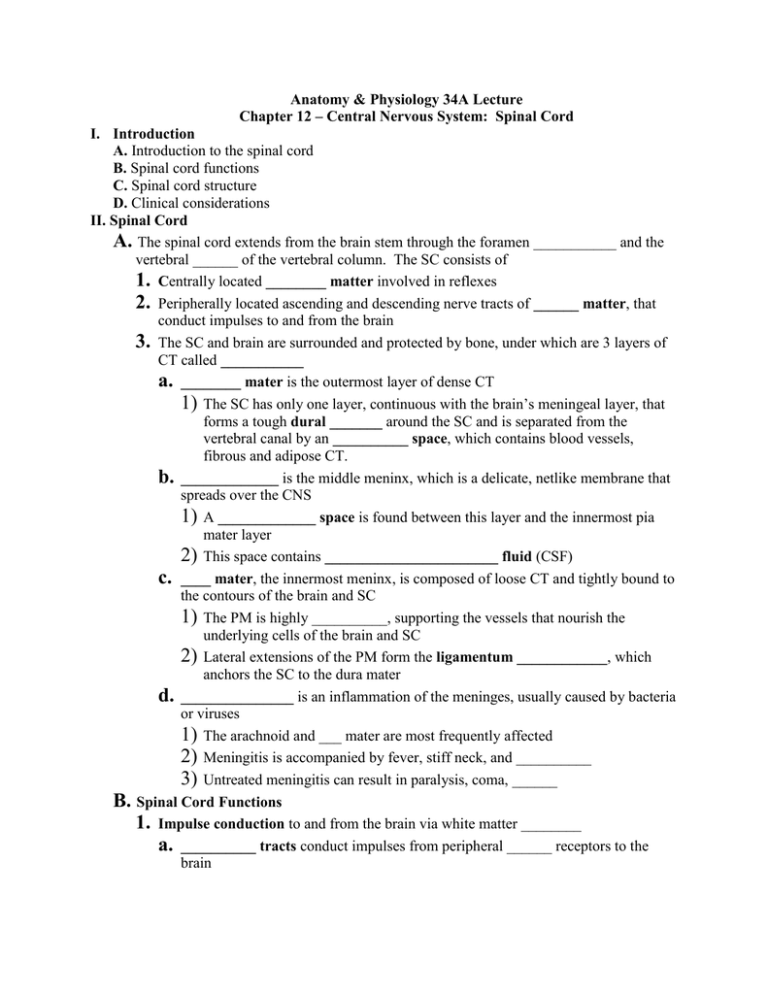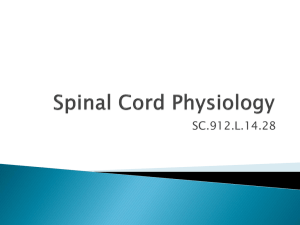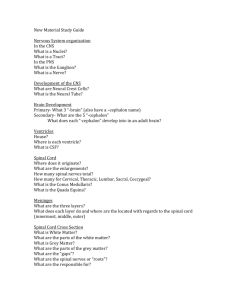Central Nervous System: Spinal Cord
advertisement

Anatomy & Physiology 34A Lecture Chapter 12 – Central Nervous System: Spinal Cord I. Introduction A. Introduction to the spinal cord B. Spinal cord functions C. Spinal cord structure D. Clinical considerations II. Spinal Cord A. The spinal cord extends from the brain stem through the foramen ___________ and the vertebral ______ of the vertebral column. The SC consists of 1. Centrally located ________ matter involved in reflexes 2. Peripherally located ascending and descending nerve tracts of ______ matter, that conduct impulses to and from the brain 3. The SC and brain are surrounded and protected by bone, under which are 3 layers of CT called ___________ a. ________ mater is the outermost layer of dense CT 1) The SC has only one layer, continuous with the brain’s meningeal layer, that forms a tough dural _______ around the SC and is separated from the vertebral canal by an __________ space, which contains blood vessels, fibrous and adipose CT. b. _____________ is the middle meninx, which is a delicate, netlike membrane that spreads over the CNS 1) A _____________ space is found between this layer and the innermost pia mater layer 2) This space contains _______________________ fluid (CSF) c. ____ mater, the innermost meninx, is composed of loose CT and tightly bound to the contours of the brain and SC 1) The PM is highly __________, supporting the vessels that nourish the underlying cells of the brain and SC 2) Lateral extensions of the PM form the ligamentum ____________, which anchors the SC to the dura mater d. _______________ is an inflammation of the meninges, usually caused by bacteria or viruses 1) The arachnoid and ___ mater are most frequently affected 2) Meningitis is accompanied by fever, stiff neck, and __________ 3) Untreated meningitis can result in paralysis, coma, ______ B. Spinal Cord Functions 1. Impulse conduction to and from the brain via white matter ________ a. __________ tracts conduct impulses from peripheral ______ receptors to the brain 2 b. ___________ tracts conduct ______ impulses from the brain to the muscles and glands 2. __________ integration – the SC gray matter core is a center for spinal reflexes of skeletal muscles, cardiac & smooth muscles C. Spinal Cord Structure 1. The SC extends from the foramen magnum to the first lumbar vertebrae (___) and has 31 paired spinal nerves extending through the ________________ foramina laterally from C1 to S5 2. Two prominent SC __________________ are: a. ___________ enlargement located between C3 & T2; spinal nerves extending from this region serve the ________ extremities b. __________ enlargement located between T9 & T12; nerves extending from this area serve the ________ extremities 3. The tapering, terminal SC portion at T12 is the ________ ___________ 4. The ______ ____________, composed mostly of pia mater, extends inferiorly from the conus medullaris from L1 to the ________ 5. Nerve rootlets, called the _______________ (horse’s tail), radiate inferiorly from the conus medullaris through the vertebral canal 6. Two grooves, an ___________ median _________ and a __________ median _______, extend the length of the SC and divide it into right and left portions 7. The SC is composed of centrally located ______ matter surrounded by _______ matter a. The ______ matter core resembles an “__” and is composed of nerve cell bodies, neuroglia, and ___________ association neurons (interneurons) 1) Paired ____________ horns extend dorsally, and contain axons of _________ neurons. 2) Paired ____________ horns extend ventrally, and house the cell bodies of __________ motor neurons. 3) Paired ___________ horns between posterior and anterior horns extend laterally, and contain the cell bodies of _________________ motor neurons. 4) The gray ____________ connects the paired horns across the center of the SC 5) Within the gray commissure is the central ______, which is continuous with the brain ventricles and contains CSF b. The white matter consists of bundles, or __________, of _________ nerve fibers of ascending sensory and descending motor neurons. There are 6 columns of tracts called ___________ 1) Two __________ funiculi are found between the anterior gray horns 2) Two _________ funiculi are located between the posterior gray horns 3) Two ______ funiculi are between the anterior & posterior gray horns 3 4) Each funiculus has both ascending and descending tracts, named according to 7. 8. their origin and termination. Some nerve tracts cross over (______________) in the MO 5) _____________ (sensory) tracts include the following: a) Fasciculus _________ & __________ - dorsal; conduct impulses from proprioceptors in skin, upper limbs, trunk & neck to the M.O., where they are relayed to the thalamus, then the cerebral somato__________ cortex b) Anterior & lateral __________ - conduct impulses for touch, pressure, pain, and temperature to the ________, where they are relayed to somatosensory cortex for interpretation c) Anterior & posterior spino___________ - conduct impulses from the trunk & lower limb proprioceptors to the _________________ for muscle coordination 6) _____________ (motor) tracts include: a) Anterior & Lateral ________spinal (pyramidal) – decussate and conduct impulses from the cerebral _____________cortex to spinal nerves for voluntary skeletal muscle movements b) ________spinal - conduct impulses from the vestibular nucleus that receives impulses for balance from the inner ear; controls limb muscles to help maintain balance and posture c) Anterior, medial, & lateral ______________spinal - conduct impulses from the __________ formation (in pons & medulla) that control posture and balance Anterior and posterior white ____________ connect the white matter of left and right sides of the SC _________ ___________ - 31 paired nerves extending laterally from the spinal cord include: a. 8 pr. _________ b. 12 pr. ________ c. 5 pr. _________ d. 5 pr. _________ e. 1 pr. _________ f. Spinal nerves enter or leave the SC via dorsal or ventral ________ 1) ________ (afferent) nerves enter via the ________ root _____________ 2) _______ (efferent) nerves leave via the _________ root g. After passing through the intervertebral formen, spinal nerves divide into branches called _______ 1) The _______ ramus serves the deep ___________ and ____ of the dorsal trunk 2) The ________ ramus serves the ______ and structures of the upper and lower _____ and the lateral and ventral trunk. 4 a) Many ventral rami spinal nerves form _________ (nerve networks) including the cervical, brachial, lumbar, and sacral plexuses b) Ventral rami of spinal nerves T2-T12 are the ___________ (thoracic) nerves h. The __________ ________ (vertebral chain) _________ lie in vertical rows on both sides of the vertebral column (like 2 strings of beads), extending from the base of the skull to the coccyx III. Clinical Considerations A. Neurological assessments (spinal cord) & drugs 1. A lumbar puncture (___________) is performed by inserting a needle between L3 & L4 and withdrawing CSF from the ________________ space for analysis 2. Epidural anesthesia is sometimes injected into the ________________ space of the lumbar region of the spine to ease the trauma of child birth B. Developmental Problems of the Spinal Cord 1. _____________ - some vertebrae don’t fuse around the SC; may cause neurological problems; can often be prevented by adequate ______________ in the mother’s diet 2. Spina bifida ________ - a sac-like protrusion of skin and underlying meninges that may contain portions of the SC and roots; most common in lower thoracic, lumbar, and sacrum; may result in hydrocephalus and paralysis if untreated. C. Spinal Cord Damage 1. _____________ – paralysis of the lower limbs due to damage to the spinal cord between T1 & L2. 2. ______________ – paralysis of all four limbs due to damage to the cervical region of the spinal cord






